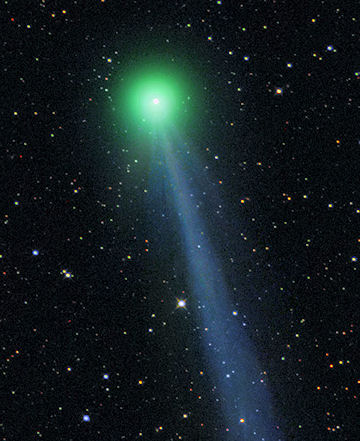
Posted on 06/07/2010 1:05:41 PM PDT by TaraP
COMET McNAUGHT: A fresh comet is swinging through the inner solar system, and it is brightening rapidly as it approaches the sun. Presenting, Comet McNaught (C/2009 R1):
Michael Jäger of Stixendorf, Austria, took the picture on June 6th using an 8-inch telescope. The comet's green atmosphere is larger than the planet Jupiter, while the long willowy ion tail stretches more than a million kilometers through space. These dimensions make the comet a fine target for backyard telescopes.
Comet McNaught can be found low in the northeastern sky before dawn gliding through the constellation Perseus. It is brightening as it approaches Earth for a 1.13 AU close encounter on June 15th and 16th. Currently, the comet is at the threshold of naked eye visibility (5th to 6th magnitude) and could become as bright as the stars of the Big Dipper (2nd magnitude) before the end of the month. Estimates are uncertain, however, because this comet is a newcomer to the inner solar system, and thus somewhat unpredictable. Readers are encouraged to wake up before dawn and monitor developments. 
That flick was on Saturday night. I sat through it just for giggles.
if that’s the case, then when a comet is in the middle of deep space, wouldn’t it look like a sphere and be dark, since there would be nothing to light it up
of course, the stuff being pushed outwards might not happen as the mass itself isn’t being heated
Apparently the comet passed by the earth in 2007 along what was originally described as a hyperbolic path -- meaning it would make its way through the solar system and never return. Somewhere along the way its trajectory was altered and it ended up in an elliptical orbit that is typical of a periodic comet. So now it is back three years later. That's a very short period for a comet.
The 2007 visit was spectacular, but didn't get a lot of attention here in the U.S. because it was mainly visible from the Southern Hemisphere. It was clearly visible during daylight hours for a while, and some of the most spectacular images I've seen are the ones that show the long wisp of the comet's tail rising from the horizon even as the head was no longer in view above the horizon.

Not only did I see Hale-Bopp, but I saw Comet Hyakutake as well.
We're those crickets I was hearing on the other video?
BTW, the cost of used good digital cameras and medium sized scopes have come down....Best to buy used first and see if the interest remains.
I’m working night shift - So all I will need to do is walk outside and look up.
(Where’s Perseus?)
M-1 - 14x60sec Camera Canon 40D.
M1 is the remnant of a star that exploded as a supernova which was observed in ancient times around 1054 by the Chinese.

 |
||
| · join · view topics · view or post blog · bookmark · post new topic · subscribe · | ||
This is a different Comet McNaught. Robert McNaught has 54 named after him.
I would have thought he'd have added some variety to these things by adding other distinctive ways of telling them apart. Like maybe giving them "first" names . . . Comet Robert McNaught, Comet Julio McNaught, etc.
A comet can have two tails.
One is made up of neutral dust particles and water vapor. Those get pushed around by the solar wind and while initially streaming out behind it (along the path it has travelled) it will end up pointing away from the sun, even if that’s 90 degrees away from where the comet is going.
The other is made up of ions and other electrically charged particles. Those follow the solar magnetic field. That can be a different direction. Post #16 in this thread shows an example.
Crickets! You bet.
I don’t turn off the audio.
The Shuttle video was the first video I did like that. I have learned to use a tripod for such things now.
A few weeks ago, I was at Disney World when Atlantis went up. I got some video of that, but, haven’t put it up yet. I’ll post a note or something when I do.
Super shot!
One of my favorite objects.
Keep’um coming!
The official designation does that. This one is C/2009 R1 = first comet discovered in first half of September, 2009. The great comet of 2007 was C/2006 P1 (first comet discovered in the first half of August 2006).
I don’t think that the discoverer is given the option of what to name comets that he or she discovers anymore. They’re all named Comet [Discoverer], followed by a code of what quarter of what year it was discovered, whether it’s periodic or not (has an orbit known or calcluated to be 200 years or less) and if it is then a sequential number for it.
“Daddy would have given us Uzis!”
Thanks....It'll take a while, just got in.... Appreciate the nice comment.
See 19 and 28..


Disclaimer: Opinions posted on Free Republic are those of the individual posters and do not necessarily represent the opinion of Free Republic or its management. All materials posted herein are protected by copyright law and the exemption for fair use of copyrighted works.